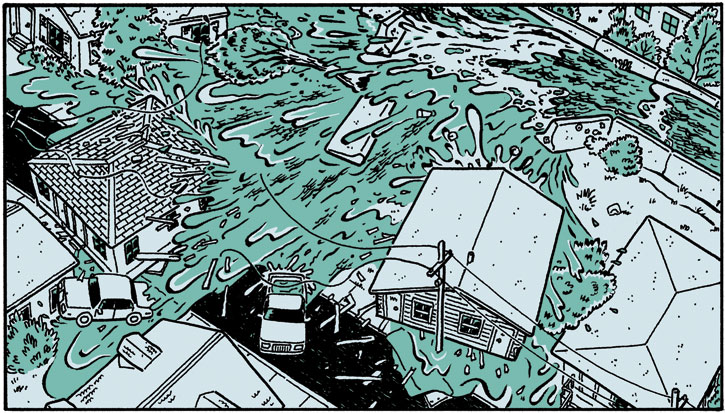
Every Thursday in August, we're featuring something about Hurricane Katrina. The storm hit New Orleans and the Gulf Coast of Mississippi four years ago, on Aug. 29, 2005. Last week, we reviewed Zeitoun by Dave Eggers. For this week, here's a review of A.D. New Orleans After The Deluge.
A.D. New Orleans After The Deluge
by Josh Neufeld
Pantheon Books, 2009
To my knowledge, this is the first major graphic novel work about Hurricane Katrina to emerge, and it first appeared as part of an ongoing web-comic on Smith Mag. But the subject matter is primarily visual--that's why Spike Lee's When the Levees Broke is more powerful than Jed Horne or Douglas Brinkley's excellent accounts. But this disaster had incredible access. TV cameras couldn't make it inside the World Trade Center. Columbine happened and then it was over with small snatches of video evidence.
But this event unfolded on the outside over several days, people struggling to get out into the open rather than to slink and hide inside the privacy of their homes. These people needed to be seen, needed to be on television, needed to be heard, needed to be saved. With those visuals still in our collective conscience, Hurricane Katrina and its complicated aftermath is great for a graphic novel.
Wow, what a challenge. Maus set the bar incredibly high for those that wade in after it. Neufeld, of American Splendor fame, chooses to work only in a single color for sets of panels, veering from dull neon yellow to mauve, to light green. It's a subtle reminder that all of the stories are told through rose-colored glasses, views marred by individuals. It also shows the limited options that each character has at their disposal. Though most pages use three to four panels to move the story, Neufeld uses large single pages and double trucks to display the power of nature. A swirling toilet bowl mirrors the gathering storm, a smoky black and yellow colored storm cloud looks like a nuclear bomb, Abbas and Darnell through the dark sludge of mud along the street after Abbas' store had been overwhelmed with water.
The individual story is fascinating (such as in Zeitoun), but that limited view is like eating too much chocolate cake--too much of it leaves deficiencies. But to switch to generalities loses the narrative story, the history books already do that. So Neufeld chooses five people to make his snapshot, five from different neighborhoods with different ethnicities who make different choices about how to deal with the storm. Not too many, not too few, just enough. Their hardships in animated form do not detract from the desperation in the situation, but create and allow visual images for where the cameras could not go and could not capture.

(From Smith Magazine)
Neufeld uses his own incredible visual imagination and perspective to demonstrate those in an intimate and personal way, such as Denise falling headfirst at the reader as the storm befalls her house. At the time of the event, she stared at a wall or some other inanimate object, but here she stares at us, the reader and we are as incapable of helping her now as we were then.
But now, thanks to Neufeld, we can empathize. We see her perspective. Some of the stories gets the short end of the stick. The doctor in the French Quarter who is never under any sort of threat gets little ink--his story is true and honest and needs to be told--like how the French Quarter experienced minimal damage--if only to stand in contrast to the more turbulent tale of Denise, who leaves from a crowded hospital, only to have her roof fall in and then eventually end up at the storied Convention Center.
Neufeld tries to include some of the actual realities and small successes--Leo offers foreboding warnings about the fate of his comic books and other possessions, him and Michelle rejoice when the FEMA checks come. Their good fortune at the ATM and lounging at a friend's house is in stark contrast to Abbas and Darnell sleeping on a roof. Though those are subtle jabs at the politics, in a few places the characters overexplain "thugs looting" for water to give to others versus "police getting supplies" to take care of themselves.
Of course, Neufeld is justified--those points were lost on the media the first time around, so he makes sure everybody gets it this time. The monochromatic scenes change once the characters return and start to rebuild their lives--they are highlighted in a different color than their surroundings, marked as a special breed in a special class--the displaced, the refugees, the returnees to New Orleans giving and sharing their stories after losing so much. In A.D., Neufeld uses an expressive medium to compensate for the feelings that words often miss--the significance of destruction, the loneliness, the frustration at an injust system. Though A.D. is only a glimpse into all of those, it's really all that's needed.





No comments:
Post a Comment